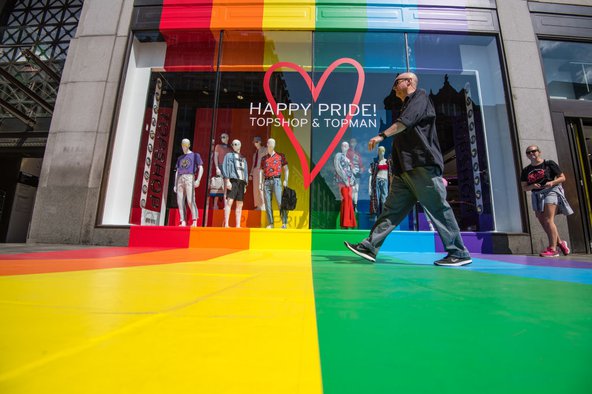The pink pound’s hidden history
by Dr Justin Bengry
6 Jul 2018
The pink pound is not what you think it is; or, rather, I want to convince you that it’s a lot more than you think it is. Depending on whom you think has most agency in commercial relationships, the pink pound (or pink economy) has generally been defined as the spending power of gay men and lesbians, or as an increasingly lucrative target market courted by some savvy marketers. Proponents of the value of the pink pound describe gay men in particular as having a greater disposable income than the average consumer and as being earlier adopters of new products. According to an Ingenious Group marketing conference in 2006, the pink pound was already worth some £70 billion to British business.

The complicated relationship between homosexuality and consumer capitalism
Most scholarship on gay consumers (and this generally focuses mostly on gay men, rather than lesbian, bi, trans or queer people) suggests that it was not until the 1980s that businesses sought to access the buying power of homosexuals, essentially identifying a queer consumer for the first time. However, my research has shown that there is a much earlier and very complicated relationship between homosexuality and consumer capitalism. I’m particularly interested in the period before gay liberation in the early 1970s, a period that included the criminalisation of all sex between men, and a period when commercial interest in homosexuality and homosexuals was not supposed to exist.
Redefining the Pink Pound
I seek to redefine the pink pound more broadly as any financial incentive offered by LGBTQ people, homosexuality and queerness. This could, unsurprisingly, include actively courting any combination of LGBTQ consumers. It might also rely upon the strategic invocation of homosexuality, or gender and sexual non-conformity, either through negative characterisations or progressive support, in order to appeal to particular market segments, which don’t actually need to be queer themselves. So, for example, people opposed to LGBTQ equality might support businesses precisely because of their shared homophobic positions. Approaching the pink pound with this broader scope in mind reveals the myriad ways in which homosexuality has long been embedded in the history of capitalism and consumer society.
Identified as potential consumers since the 19th century
What I’ve discovered is that from at least the late 19th century producers and purveyors of consumer goods and services were grappling with how to address a segment of people, men at first, whose gender expression and presumed sexual interests fell outside both normative masculinity and the law.
These entrepreneurs, capitalists and social observers rarely cared that the consumers they sought were anathema to many. Instead, based on these consumers’ gender or sexual alterity, producers and retailers recognised these men as potential consumers of particular kinds of goods and services: at first scent, clothes, accessories and the publications that described them. What fascinates me is that business interests were seeking to define and categorise men who appeared to have something in common, and who appeared to consume in certain queer ways, even if those men did not yet self-identify as a cohesive group or subculture.
By the mid-20th century I have uncovered a growing number of queer entrepreneurs, men who recognised in their own social worlds similar men who consumed differently than non-queer men. And being insiders allowed them access to particular codes and shared understandings that could be used in publications and advertisements to attract other queer men. No one has previously looked at these sources for evidence of a self-aware queer entrepreneurialism stretching back more than half a century in the UK.
I’m currently completing this study, undertaking oral history interviews with LGBTQ people about their buying habits, business activities, and awareness of market forces in their lives from the 1950s to the 1970s. The interviews have been kindly supported with funds from a British Academy / Leverhulme Small Research Grant. The book, titled The Pink Pound: Capitalism and Homosexuality in Twentieth-Century Britain, is under contract with the University of Chicago Press.
Dr Justin Bengry is Lecturer in Queer History and convenor of the world’s first MA in Queer History at Goldsmiths, University of London. His project 'The Pink Pound: Capitalism and Homosexuality in Britain' was partly funded by a British Academy/Leverhulme Small Research Grant.


